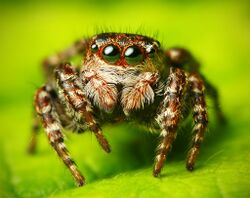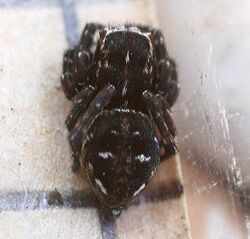Biology:Calositticus
| Calositticus | |
|---|---|

| |
| Calositticus floricola | |
| Scientific classification | |
| Domain: | Eukaryota |
| Kingdom: | Animalia |
| Phylum: | Arthropoda |
| Subphylum: | Chelicerata |
| Class: | Arachnida |
| Order: | Araneae |
| Infraorder: | Araneomorphae |
| Family: | Salticidae |
| Genus: | Calositticus Lohmander, 1944[1] |
| Type species | |
| Attus caricis (Westring, 1861)[1]
| |
| Diversity[1] | |
| 12 species | |
| Synonyms[1] | |
|
Sittiflor Prószyński, 2017 | |
Calositticus is a spider genus of the Salticidae family (jumping spiders). The genus was split off from its sister genus Sitticus by Jerzy Prószyński in 2017, initially under the name Sittiflor. It was later discovered that this name was pre-empted by Calositticus.
Description
Calositticus species have body lengths of around 4–6 mm (3⁄16–1⁄4 in). They are relatively dark in colour, from light brown to almost black, with distinct rings on their legs. Most species have two white spots on the posterior half of the abdomen accompanied by a light-coloured streak. This pattern varies both within and between species, being absent in Calositticus caricis.[2]
Taxonomy
Calositticus is one of a number of genera that were split off from the broadly defined genus Sitticus by Jerzy Prószyński in 2016 and 2017. Prószyński used the genus name "Sittiflor", derived from the first parts of the generic and specific names of Sitticus floricola.[2] It was later discovered that Sittiflor was pre-empted by Calositticus, a name used by Lohmander in 1944 for a subgenus of Sitticus.[3]
Calositticus males are distinguished by the almost round palpal bulb, with an S-shaped loop visible centrally. In females, the spermathecae are C-shaped, but with unequal branches, the anterior one being shorter.[2]
Species
(As of September 2018), the World Spider Catalog accepted the following species:[1]
- Calositticus atricapillus (Simon, 1882) – Europe, Turkey
- Calositticus caricis (Westring, 1861) (type species) – Europe, Turkey, Caucasus, Russia to Kazakhstan, Mongolia
- Calositticus cutleri (Prószyński, 1980) – North America, Russia (Sibiria to Far East)
- Calositticus dudkoi (Logunov, 1998) – Russia
- Calositticus floricola (C. L. Koch, 1837) – Europe, Caucasus, Russia to Central Asia, China, Japan
- Calositticus inexpectus (Logunov & Kronestedt, 1997) – Europe to Central Asia
- Calositticus magnus (Chamberlin & Ivie, 1944) – USA
- Calositticus monstrabilis (Logunov, 1992) – Central Asia
- Calositticus pulchellus (Logunov, 1992) – Kazakhstan, Kyrgyzstan
- Calositticus rupicola (C. L. Koch, 1837) – Europe
- Calositticus striatus (Emerton, 1911) – USA, Canada, France
- Calositticus zimmermanni (Simon, 1877) – Europe to Central Asia
Distribution and habitat
Calositticus species are widely distributed in the Northern Hemisphere, mainly through Europe to Siberia, but also in North America.[1][2] The habitat preferences of the species vary considerably. Calositticus floricola, C. caricis and C. inexpectus are found in damp environments, such as wet meadow and beside bodies of water. C. rupicola by contrast is found on mountains, building its nests between rocks and stones.[2]
References
- ↑ 1.0 1.1 1.2 1.3 1.4 1.5 "Gen. Calositticus Lohmander, 1944", World Spider Catalog (Natural History Museum Bern), http://www.wsc.nmbe.ch/genus/5679, retrieved 2018-09-29
- ↑ 2.0 2.1 2.2 2.3 2.4 Prószyński, J. (2017), "Revision of the genus Sitticus Simon, 1901 s. l. (Araneae: Salticidae)", Ecologica Montenegrina 10: 35–50
- ↑ Blick, T. & Marusik, Y.M (2018), "Three junior synonyms of jumping spider genera (Araneae: Salticidae)", Arthropoda Selecta 27 (3): 237–238
Wikidata ☰ {{{from}}} entry


